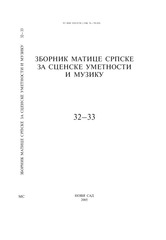Приказ основних података о документу
О мелодији божићног кондака трећег гласа Дјева днес
On the Third Part Melody of the Christmas Kontakion (Djeva Dnes)
| dc.contributor | Ковачек, Божидар | |
| dc.creator | Пено, Весна | |
| dc.date.accessioned | 2020-11-25T20:27:50Z | |
| dc.date.available | 2020-11-25T20:27:50Z | |
| dc.date.issued | 2005 | |
| dc.identifier.issn | 0352-9738 | |
| dc.identifier.uri | https://dais.sanu.ac.rs/123456789/9562 | |
| dc.description.abstract | Проимион божићног кондака трећег гласа, Дјева днес, који представља модел према коме се певају сви кондаци трећег гласа, послужио је у раду као узорак на основу кога се разматра проблем напева у новијој српској појачкој традицији. Изузетност ове мелодије унутар трећег гласа доведена је у везу са самогласним — мелопоетским типом који управо подразумева специфичну структуру текста и посебну мелодију. Ова мелодија је сачувала своје препознатљиве обрисе током низа векова, што је у раду представљено на одговарајућим неумским — византијским, касновизантијским и грчким записима, као и нотним — српским записима. | sr |
| dc.description.abstract | Serbian melographers and authors of the texts about church music noticed the specifities in the melody of the kontakion (Djeva Dnes) within the tune for the third part of the octoechos singing. Some Serbian researchers tried to relate the specificity of the kontakion melody to the Byzantine, that is Greek sources according to which it was formed, not entering into an additional analysis which would explain the noticed similarity. However, some other researchers simply gave a specific name to the exception within the third part melody, not trying to explain its appearance. Comparative music analysis of the mentioned kontakion — on the basis of the transcriptions from the manuscripts Leningrad 674 (13th century) and Zakinthos 8 (AD 1689) made by Jürgen Rasted, then of the contemporary Neum transcription of the Greek theoretician Simon Karas in the „new method", and of the transcription of the same song in Stevan Mokranjac's European notation — showed that the mentioned kontakion, in spite of a long-standing oral tradition, was preserved with slight changes during the long history of church chant. This fact challenges the opinion of some Serbian authors who related the exception in the kontakion melody exclusively to the more recent Greek influences under which contemporary Serbian chanting was formed. The paper views the causes of the noticeable similarity between the temporally distant transcriptions and mutually very close, but also independent traditions, from the standpoint of different kinds, more precisely functions which specific songs had within the entire repertoire of church hymnography. Namely, idiomel as a melopoetic model — according to whose textual and melodic pattern the prescribed songs were sung — in the case of the Christmas kontakion (Djeva Dnes) also appeared to be very stable, in spite of all changes which oral tradition brings by definition. It is not possible to study the specificity of this idiomel outside the framework of the manuscript heritage, but it is possible to assume that its recognizeable mark — both in the form of its verses and in its melodic shape — was provided by its author, the famous hymnographer and melodist, St. Romanos. | en |
| dc.language.iso | sr | sr |
| dc.publisher | Нови Сад : Матица српска, Одељење за сценске уметности и музику | sr |
| dc.rights | openAccess | sr |
| dc.rights.uri | https://creativecommons.org/licenses/by-nc-nd/4.0/ | |
| dc.source | Зборник Матице српске за сценске уметности и музику | sr |
| dc.title | О мелодији божићног кондака трећег гласа Дјева днес | sr |
| dc.title | On the Third Part Melody of the Christmas Kontakion (Djeva Dnes) | en |
| dc.type | bookPart | sr |
| dc.rights.license | BY-NC-ND | sr |
| dcterms.abstract | Peno, Vesna; O melodiji božićnog kondaka trećeg glasa Djeva dnes; | |
| dc.citation.spage | 25 | |
| dc.citation.epage | 41 | |
| dc.citation.issue | 32-33 | |
| dc.identifier.cobiss | 16339202 | |
| dc.type.version | publishedVersion | sr |
| dc.identifier.fulltext | https://dais.sanu.ac.rs/bitstream/id/39849/bitstream_39849.pdf | |
| dc.identifier.rcub | https://hdl.handle.net/21.15107/rcub_dais_9562 |

